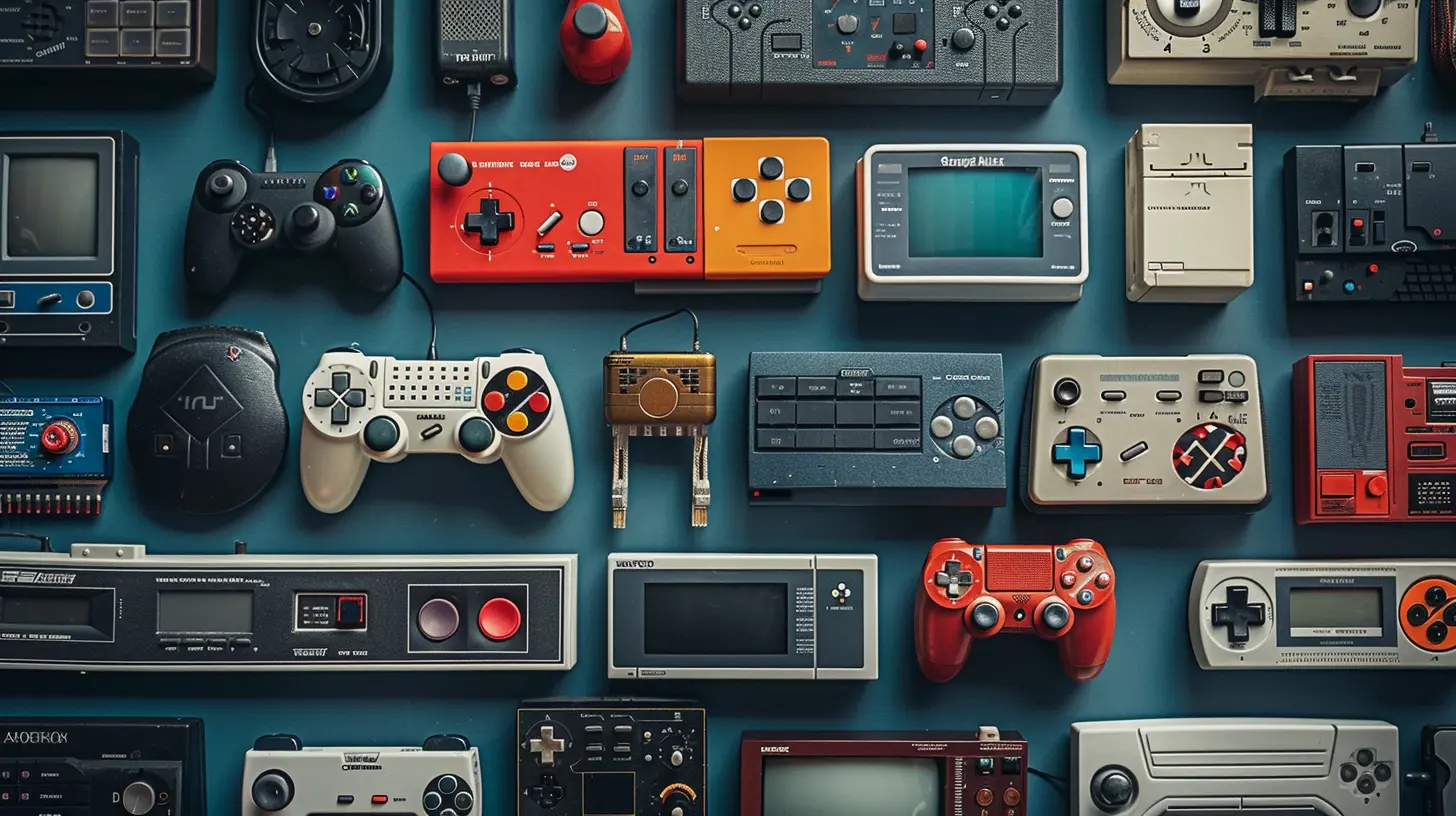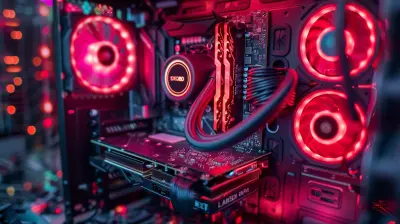6 February 2025
When you think of gaming, what's the first thing that comes to mind? For most of us, it's not just the spectacular graphics or the captivating storylines; it's the controllers—the magical tools that connect our hands to virtual worlds. Game controllers have come a long way, evolving from blocky joysticks to sleek, futuristic VR setups. Ever wondered how we went from twisting bulky knobs to literally waving our hands in the air? Let's dive into the history of game controllers and trace the journey that reshaped gaming as we know it.
The Early Days: Knobs, Buttons, and the Birth of Joysticks
Gaming's humble beginnings didn’t involve ergonomic controllers or customizable buttons. Back in the early 1970s, arcade cabinets ruled the scene. It all started with Pong (1972), a simple yet addictive game where players bounced a pixelated ball across the screen. The "controller" here? A rotary knob, also called a paddle, that allowed you to move a paddle up and down. Simple tools for a simple game.But soon, as games grew more complex, so did their control schemes. Enter the joystick! The first notable joystick appeared with Atari's Arcade Game, Spacewar in the early '70s. Shortly after, the Atari 2600 console brought the joystick into homes worldwide. It was a single-button stick. Yep, just one button—and we all thought it was revolutionary. Compared to today’s 15-button controllers, it sounds like a caveman tool, but back then, it was the golden age of control simplicity.
The 1980s: The Rise of Directional Pads (D-Pads)
The arcade joystick might have been king, but the home console market wanted something more compact and user-friendly. Enter the directional pad, or D-Pad, pioneered by Nintendo. The D-Pad made its grand debut on the Game & Watch handheld in 1980 before becoming iconic with the launch of the Nintendo Entertainment System (NES) in 1983.For those of us fortunate enough to play NES classics like Super Mario Bros., the D-Pad offered precision control without the clunkiness of a joystick. It was a thumb-friendly innovation that laid the foundation for modern controllers. Think of it as gaming's version of transitioning from typewriters to computer keyboards—it just felt right.
Meanwhile, Sega was also making waves with its Master System Controller, and arcade-inspired buttons found their way into living rooms. Controllers were becoming more sophisticated, but they still had a long journey ahead.
The 1990s: Enter Ergonomics and Analog Sticks
Fast forward to the '90s, and gaming was evolving at lightning speed. The arrival of 3D gaming meant that flat 2D D-Pad controls weren’t enough anymore. Players needed more freedom to move in three dimensions. The solution? Analog sticks!In 1996, Nintendo 64 (N64) dropped a bombshell on the gaming world with its revolutionary controller. The N64 controller featured a center-placed analog stick that allowed players to experience full 360-degree control for iconic games like Super Mario 64. For many, this was the first time gaming felt truly immersive. It was no longer just pressing buttons; it was about fluid motion, like steering a spaceship instead of a car.
Around the same time, Sony entered the fray with the launch of the PlayStation DualShock controller in 1997, a design featuring two analog sticks and rumble functionality. Yes, folks, vibration controllers were born! This was gaming’s equivalent of adding hot sauce to an already delicious meal—suddenly, everything was more exciting.
The 2000s: Wireless Revolution and Motion Controls
Ah, the 2000s. By this time, consoles like PlayStation 2, Xbox, and GameCube were duking it out in living rooms everywhere. Controllers became more ergonomic, with smoother curves and better button placement. But the real game-changer (pun intended) was wireless controllers.Imagine this: no more tripping over cords or awkwardly dragging your console closer to the TV so the wire could reach. The Xbox 360’s wireless controller, introduced in 2005, set a new benchmark for convenience and flexibility. It used radio waves to connect to the console, something we now take for granted but was mind-blowing at the time.
Then, in 2006, Nintendo Wii shook the market—literally. The Wii Remote (or Wiimote) brought motion controls to the masses. Instead of pressing buttons, you could swing the controller like a tennis racket, bowl like a champ, or even dance like no one was watching. For the first time, gaming felt active, physical, and wildly fun for people of all ages.
The 2010s: Touchpads, Customization, and the Rise of VR
The 2010s saw controllers becoming smarter and more versatile. Sony added a touchpad to the PS4 DualShock 4, broadening how players could interact with games—think swiping, tapping, and even typing. Microsoft upped the ante with Xbox One controllers, offering robust construction and an elite version with swappable components for pro-level customization.But let’s not forget about handheld gaming, which took a huge leap with the Nintendo Switch in 2017. The Joy-Cons were detachable controllers that proved portability didn’t mean sacrificing functionality. Want to play solo? Snap them onto the console. Gaming with a friend? Share each Joy-Con for a quick Mario Kart session.
Then came Virtual Reality (VR) controllers like the Oculus Touch and HTC Vive Wands. Suddenly, gaming was no longer confined to screens—it was around you, and the controllers became your hands. If you’ve ever "held" a sword or painted in thin air using these controllers, you’ll know the feeling is nothing short of magical.
The 2020s and Beyond: The Future of Immersive Control
Here we are in the 2020s, and game controllers have reached a new level of sophistication. The PS5 DualSense controller introduced haptic feedback and adaptive triggers, letting you feel tension when pulling an in-game bowstring. It’s like the controller whispers, “Hey, let’s make this real for you.”Meanwhile, VR controllers continue to evolve with finger-tracking technology. Ever tried the Meta Quest Touch Pro or Valve Index Controllers? They track your fingers so precisely that you can pick up and toss virtual objects as naturally as you would in real life. Wild, right?
And we’re not stopping here. The future might hold brain-computer interfaces, where thoughts control games instead of physical inputs. It sounds like something out of Black Mirror, but tech giants are already exploring it. Imagine gaming without even lifting a finger. Who knows—maybe in a decade, controllers as we know them might disappear entirely.
Conclusion: A Journey Worth Holding On To
From the simplicity of knobs and joysticks to the immersive wonders of VR, game controllers have come a long way. They’ve not only adapted to the changing demands of games but also shaped how we play them. Each generation of controllers has brought us closer to our gaming worlds, breaking barriers between the real and the virtual.So, the next time you pick up your controller, take a moment to appreciate its journey. It’s more than just a piece of plastic—it’s a portal to creativity, adventure, and endless fun. And who knows? The next big innovation might just be around the corner.









Faelan Lambert
I'm fascinated by how game controllers have evolved! What specific innovations do you think had the biggest impact on gameplay? I’d love to hear more about the transition to VR!
March 25, 2025 at 4:54 AM